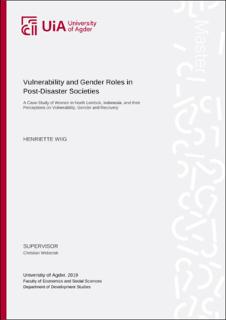| dc.contributor.author | Wiig, Henriette | |
| dc.date.accessioned | 2020-03-18T07:48:13Z | |
| dc.date.available | 2020-03-18T07:48:13Z | |
| dc.date.issued | 2019 | |
| dc.identifier.uri | https://hdl.handle.net/11250/2647293 | |
| dc.description | Master's thesis Global development and planning UT505 - University of Agder 2019 | en_US |
| dc.description.abstract | Disasters are considered as major threats to sustainable economic growth and human development and are in large referred to as natural disasters. This is despite the growing recognition of there not being such a thing as natural disasters. Disasters only occurs when a natural hazard impacts upon a vulnerable population. Disaster impacts often are often unevenly distributed, with certain vulnerable groups, such as women, being disproportionately affected. A greater focus on inclusive and preventive disaster risk reduction efforts are needed to achieve sustainable development. To achieve vulnerability reduction through disaster risk reduction, there is a need to understand how vulnerability and disaster risk is perceived in specific locations. This thesis aims to understand how women in North Lombok, Indonesia perceive their own vulnerability to disasters and what role they can play in local efforts to disaster risk reduction. Through the Pressure and Release Model, this paper investigates what are the underlying vulnerabilities of particularly women in three North Lombok villages. A focus will also be dedicated to considering the local cultural and social context in the North Lombok region and its implications for the residents in daily lives and in the earthquake aftermath. The research draws on qualitative data collected through in-depth interviews, focus group discussions and participant observation in the context of post-earthquake districts of Lombok. This thesis will claim that local perceptions of vulnerability and disasters are shaped in large by people’s experiences, and the cultural and social context of a particular location. These aspects will also be presented as factors that contribute to remaining poverty and social differences within a community. Which is of particular importance in North Lombok region where traditional culture and values are embedded in the social structure of the local communities. Vulnerability is also seen as being linked to the levels of local risk reduction policies and agencies and their implications on physical vulnerabilities in the built environment. The national and local disaster management agencies and efforts will also be studied in terms of pre-and post-earthquake conditions. This will show thatthe importance of a reliable government at all levels is important to build a resilient community. | en_US |
| dc.language.iso | eng | en_US |
| dc.publisher | Universitetet i Agder ; University of Agder | en_US |
| dc.rights | Attribution-NonCommercial-NoDerivatives 4.0 Internasjonal | * |
| dc.rights.uri | http://creativecommons.org/licenses/by-nc-nd/4.0/deed.no | * |
| dc.subject | UT505 | en_US |
| dc.title | Vulnerability and Gender Roles in Post-Disaster Societies : A Case-Study of Women in North Lombok, Indonesia, and their Perceptions on Vulnerability, Gender and Recovery | en_US |
| dc.type | Master thesis | en_US |
| dc.subject.nsi | VDP::Samfunnsvitenskap: 200::Sosiologi: 220 | en_US |
| dc.subject.nsi | VDP::Samfunnsvitenskap: 200::Kvinne- og kjønnsstudier: 370 | en_US |
| dc.source.pagenumber | 113 p. | en_US |

